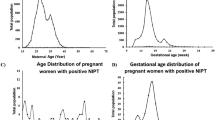Abstract
Objective
Recent reports have indicated that cell-free fetal DNA can be detected in the urine of pregnant women. We attempted to reproduce those data.
Methods
Urine samples were collected from 18 normal pregnant women (11 with a male fetus). Urinary DNA was examined by Y-chromosome-specific nested polymerase chain reaction (PCR) or real-time PCR. Samples were also examined from, two pregnancies complicated by HELLP (hemolysis, elevated liver enzymes, and low platelets) syndrome, which had very high levels of cell-free fetal DNA in the maternal plasma. To validate our data, a quantitative comparison of different DNA extraction procedures used in the previous reports was performed.
Results
In no instance were we able to detect any fetal DNA in maternal urine, although copious quantities of cell-free fetal DNA were present in the maternal plasma of those pregnancies affected by HELLP syndrome. Our quantitative analysis of the various extraction procedures used indicated that the commercial column elution method we used was comparable, if not superior, to the noncommercial methods used in previous reports.
Conclusion
Our data strongly suggest that cell-free fetal DNA is not readily detectable in maternal urine, even under conditions known to increase kidney permeability.
Similar content being viewed by others
References
Hahn S, Holzgreve W. Prenatal diagnosis using fetal cells and cell-free fetal DNA in maternal blood: What is currently feasible? Clin Obstet Gynecol 2002;45:649–56.
Chiu RW, Lo YM. Application of fetal DNA in maternal plasma for noninvasive prenatal diagnosis. Expert Rev Mol Diagn 2002; 2:32–40.
Botezatu I, Serdyuk O, Potapova G, et al. Genetic analysis of DNA excreted in urine: A new approach for detecting specific genomic DNA sequences from cells dying in an organism. Clin Chem 2000;46:1078–84.
Al-Yatama MK, Mustafa AS, Ali S, Abraham S, Khan Z, Khaja N. Detection of Y chromosome-specific DNA in the plasma and urine of pregnant women using nested polymerase chain reaction. Prenat Diagn 2001;21:399–402.
Lo YM, Zhang J, Leung TN, Lau TK, Chang AM, Hjelm NM. Rapid clearance of fetal DNA from maternal plasma. Am J Hum Genet 1999;64:218–24.
Lo YM, Leung TN, Tein MS, et al. Quantitative abnormalities of fetal DNA in maternal serum in preeclampsia. Clin Chem 1999;45:184–8.
Zhong XY, Laivuori H, Livingston JC, et al. Elevation of both maternal and fetal extracellular circulating deoxyribonucleic acid concentrations in the plasma of pregnant women with preeclampsia. Am J Obstet Gynecol 2001;184:414–9.
Swinkels DW, de Kok JB, Hendriks JC, Wiegerinck E, Zusterzeel PL, Steegers EA. Hemolysis, elevated liver enzymes, and low platelet count (HELLP) syndrome as a complication of preeclampsia in pregnant women increases the amount of cell-free fetal and maternal DNA in maternal plasma and serum. Clin Chem 2002;48(4):650–3.
Roberts JM, Redman CW. Pre-eclampsia: More than pregnancy-induced hypertension. Lancet 1993;341:1447–51.
Zhong XY, Holzgreve W, Hahn S. Detection of fetal rhesus D and sex using fetal DNA from maternal plasma by multiplex polymerase chain reaction. Br J Obstet Gynecol 2000;107:766–9.
Zhong XY, Holzgreve W, Hahn S. The levels of circulatory cell free fetal DNA m maternal plasma are elevated prior to the onset of preeclampsia. Hypertens Pregnancy 2002;21:77–83.
Troeger C, Zhong XY, Burgemeister R, et al. Approximately half of the erythroblasts in maternal blood are of fetal origin. Mol Hum Reprod 1999;5:1162–5.
Zhong XY, Holzgreve W, Li JC, Aydinli K, Hahn S. High levels of fetal erythroblasts and fetal extracellular DNA in the peripheral blood of a pregnant woman with idiopathic polyhydramnios: Case report. Prenat Diagn 2000;20:838–41.
Houfflin-Debarge V, O’Donnell H, Overton T, Bennett PR, Fisk NM. High sensitivity of fetal DNA in plasma compared to serum and nucleated cells using un-nested PCR in maternal blood. Fetal Diagn Ther 2000;15:102–7.
Lo YM, Patel P, Sampietro M, Gillmer MD, Fleming KA, Wainscoat JS. Detection of single-copy fetal DNA sequence from maternal blood. Lancet 1990;335:1463–4.
Lau TW, Leung TN, Chan LY, et al. Fetal DNA clearance from maternal plasma is impaired in preeclampsia. Clin Chem 2002; 48:2141–6.
Zhang J, Tong KL, Li PK, et al. Presence of donor- and recipient-derived DNA in cell-free urine samples of renal transplantation recipients: Urinary DNA chimerism. Clin Chem 1999;45: 1741–6.
Zhong XY, Hahn D, Troeger C, et al. Cell-free DNA in urine: A marker for kidney graft rejection, but not for prenatal diagnosis? Ann N Y Acad Sci 2001;945:250–7.
Li J, Hahn D, Zhong XY, Thomson P, Holzgreve W, Hahn S. Detection of donor-specific DNA polymorphisms in the urine of renal transplant recipients. Clin Chem 2003;49:655–8.
Lui YY, Chik KW, Chiu RW, Ho CY, Lam CW, Lo YMD. Predominant hematopoietic origin of cell-free DNA in plasma and serum after sex-mismatched bone marrow transplantation. Clin Chem 2002;48:421–7.
Lui YY, Woo KS, Wang AY, et al. Origin of plasma cell-free DNA after solid organ transplantation. Clin Chem 2003; 49:495–6.
Author information
Authors and Affiliations
Corresponding author
Additional information
This work was supported in part by Swiss National Science Foundation grant number 3200-3200-055614.98/1 and National Institutes of Health (USA) contract number N01-HD-4-3202.
Preliminary data from this study were presented at the Second Conference on Circulation Nucleic Acids in Serum and Plasma (CNAPS), Hong Kong, February 20-21, 2001, and have been published in the conference proceedings (reference 18).
Rights and permissions
About this article
Cite this article
Li, Y., Zhong, X.Y., Kang, A. et al. Inability to Detect Cell Free Fetal DNA in the Urine of Normal Pregnant Women nor in Those Affected by Preeclampsia Associated HELLP Syndrome. Reprod. Sci. 10, 503–508 (2003). https://doi.org/10.1016/S1071-55760300155-2
Published:
Issue Date:
DOI: https://doi.org/10.1016/S1071-55760300155-2



